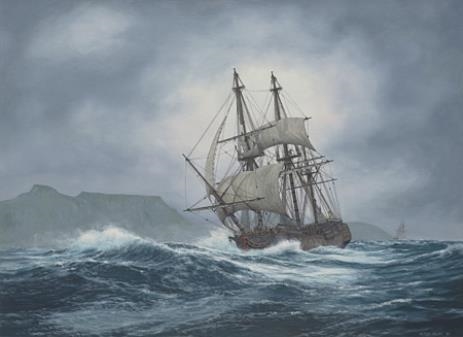Wolraad Woltemade and His Horse Vonk
It was a stormy winter's night in June 1773. All night the storm raged. There were five ships anchored in Table Bay, which were buffeted and pounded by the turbulent waves. Bright flashes of lightning lit up the imposing Table Mountain and the little settlement of Cape Town. Few of the sailors managed to sleep as their wooden ships creaked and groaned as they strained at their anchors.
Captain Barend Lameren was alarmed when his ship, De Jonge Thomas, began to drag its anchor. There were 191 men, women and children on board his ship, along with a valuable cargo from the East. As the storm intensified, just after midnight on 1 June 1773, the captain ordered the ship's cannon fired to alert those on shore that he was in dire need of help.
Original painting by Peter Baylis
Shortly after 5 a.m., De Jonge Thomas broke loose from its last anchor and was driven towards the coast, where she ran aground on a sand bar opposite the mouth of the Salt River. As wave after wave slammed into her, the ship broke in half, casting many of her crew and passengers into the raging sea. Only the strongest swimmers succeeded in reaching the shore. The rest were dragged out to sea by the strong current from the river.
Original painting by Peter Baylis
Shortly after 5 a.m., De Jonge Thomas broke loose from its last anchor and was driven towards the coast, where she ran aground on a sand bar opposite the mouth of the Salt River. As wave after wave slammed into her, the ship broke in half, casting many of her crew and passengers into the raging sea. Only the strongest swimmers succeeded in reaching the shore. The rest were dragged out to sea by the strong current from the river.
Soon a platoon of 30 Dutch soldiers came marching up. Governor Van Plettenberg had ordered them to prevent looting and to assist survivors of the shipwreck. One of these soldiers was Corporal Christian Ludwig Woltemade. The officer in charge warned people who had gathered on the shore not to go near the turbulent waters. Some had come to watch; some, to try and help; while others were opportunists hoping to loot any cargo that washed up.
As daylight came, the young soldier's father rode up on his horse Vonk (Sparkle). Wolraad Woltemade was 65 years old. Born in Germany, he had migrated to the Dutch settlement at the southern tip of Africa, where he was employed as a dairy farmer by the Dutch East India Company, probably at Jan Biesjes Kraal. He had been riding towards the farmhouse Klein Zoar (which was in all likelihood his home) when he had seen the ship in the breakers.
Woltemade was filled with pity for the helpless souls marooned aboard the wreck. Seeing that nothing could be done by those on the
beach, he mounted his horse and urged the animal into the sea. As they
approached the wreck, Woltemade turned the horse and called for two men to jump
into the sea and grasp the horse’s tail. After a moment's hesitation, two men
threw themselves into the water and did so, whereupon Woltemade urged the horse
forward and dragged them to shore. Bystanders hurried forward to help the survivors out of the swirling surf.
Original painting by the author, Simon Winter
Immediately and without a word, Woltemade turned his horse around and plunged back into the icy and mountainous sea. He rode out seven times, bringing back
fourteen men. By this time, he and his horse were exhausted, but as they rested, the ship began to sink. "Once more!" he shouted and plunged back into the sea an eighth time, making his way through the waves to the stricken ship.
By this time, those still clinging to the hull were desperate. Seeing this as probably their last chance to escape death, six men plunged into the sea, grabbing at the horse's mane, bridle, saddle and tail. Their weight was too much for the exhausted horse and they all sank beneath the waves and were drowned. Woltemade's body was recovered the next day, but the horse was not found. Of the 191 people on board, only 53 survived and of these 14 were saved by Woltemade.
In honour of Woltemade's unselfish sacrifice and bravery, the Dutch East India Company provided amply for his widow and children and named a ship De Held Woltemade (The Hero Woltemade). The name was also given to the S.A. Wolraad Woltemade, one of a pair of salvage tugs built in 1976, which at the time were the most powerful tugs in the world.
Streets and a suburb of Cape Town are also named after him. The Woltemade statue, by Mitford-Barberton, can be seen at the head office of Old Mutual in Pinelands. The Union of South Africa King's Medal for Bravery, instituted in 1939, bore a depiction of Woltemade's heroic act on its obverse. In 1970, the Woltemade Decoration for Bravery was instituted as the highest civilian decoration for bravery in South Africa. This was replaced in 1988 by the Woltemade Cross for Bravery, but this award was discontinued in 2002, as part of the move towards establishing a new South African honours system, following the advent of majority rule.
|
|
|
|






Comments
Post a Comment